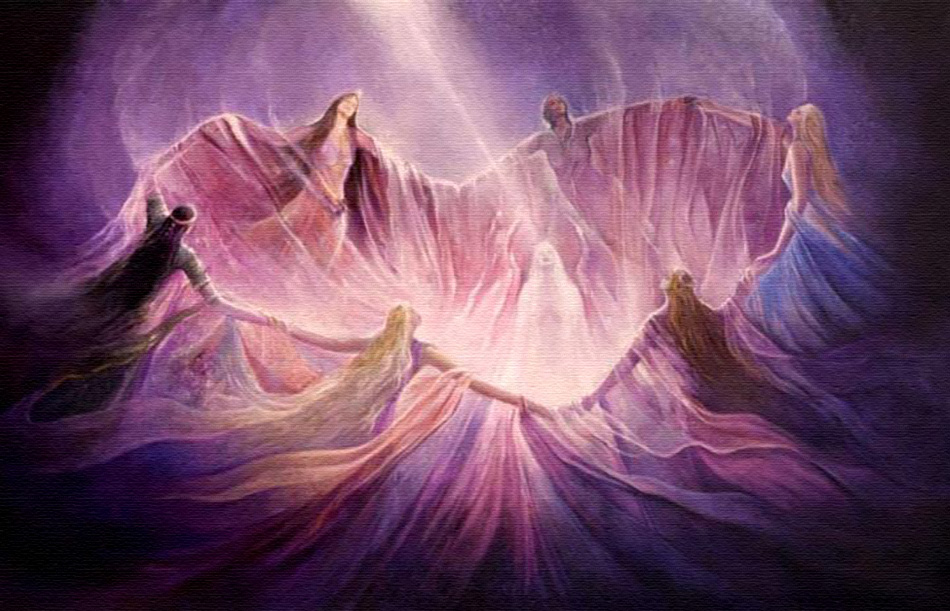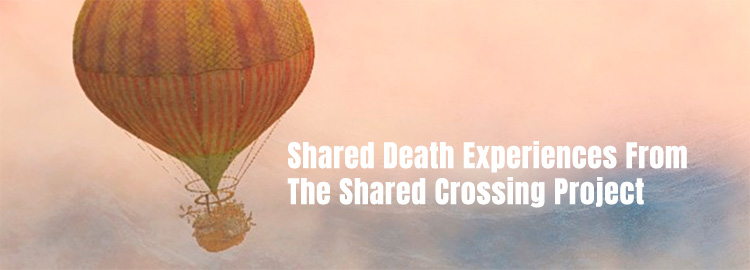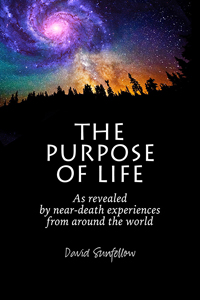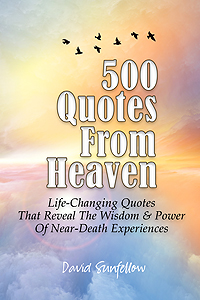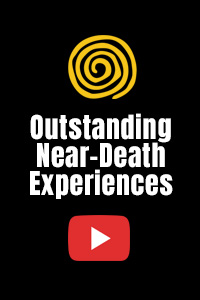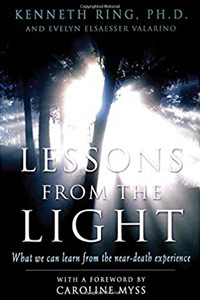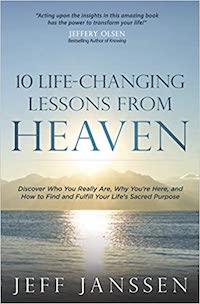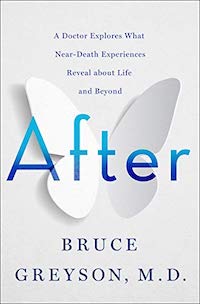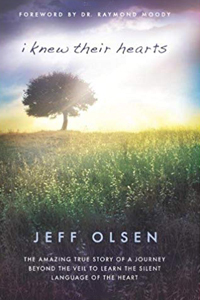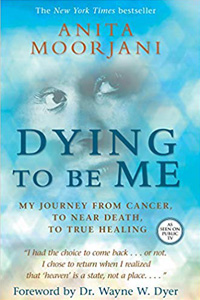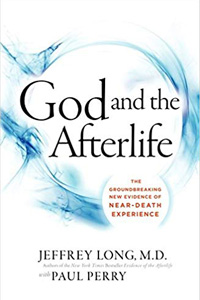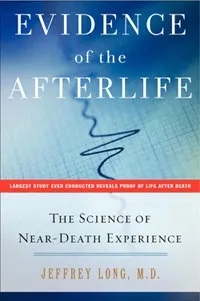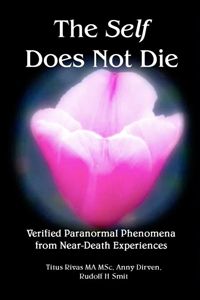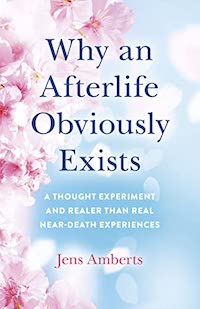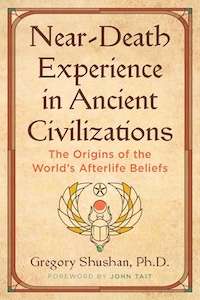At Heaven’s Door: What Shared Journeys To The Afterlife Teach About Dying Well And Living Better
By William J. Peters
Amazon Description:
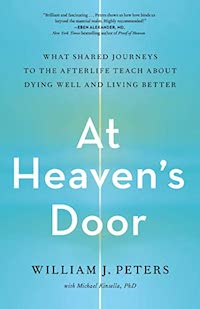 A groundbreaking, authoritative exploration — rich with powerful personal stories and convincing research — of the many ways the living can and do accompany the dying on their journey into the afterlife.
A groundbreaking, authoritative exploration — rich with powerful personal stories and convincing research — of the many ways the living can and do accompany the dying on their journey into the afterlife.
In 2000, end-of-life therapist William Peters was volunteering at the Zen Hospice Project in San Francisco when he had an extraordinary experience as he was reading aloud to a patient: he suddenly felt himself floating in midair, completely out of his body. The patient, who was also aloft, looked at him and smiled. The next moment, Peters felt himself return to his body…but the patient never regained consciousness and died.
Perplexed and stunned by what had happened, Peters began searching for other people who’d shared similar experiences. He would spend the next twenty years gathering and meticulously categorizing their stories to identify key patterns and features of what is now known as the “shared crossing” experience. The similarities, which cut across continents and cultures and include awe-inspiring visual and sensory effects, and powerful emotional after-effects, were impossible to ignore.
Long whispered about in the hospice and medical communities, these extraordinary moments of final passage are openly discussed and explained in At Heaven’s Door. The book is filled with powerful tales of spouses on departing this earth after decades together and bereaved parents who share their children’s entry into the afterlife. Applying rigorous research, Peters digs into the effect these shared crossing experiences impart — liberation at the sight of a loved one finding joy, a sense of reconciliation if the relationship was fraught — and explores questions like: What can explain these shared death experiences? How can we increase our likelihood of having one? What do these experiences tell us about what lies beyond? And, most importantly, how can they help take away the sting of death and better prepare us for our own final moments? How can we have both a better life and a better death?
………………..
Chapter 1: What Brings You Here?
I ask this question of every person who steps through the door because they have come to talk about death — the most universal of all human experiences yet the most difficult to discuss.
In modern culture, we have an uneasy relationship with death. Our language is populated with phrases such as “fear of death and dying.” Promoters of fitness regimens, grooming and beauty tricks, and cosmetic procedures tout their ability to help us “turn back the clock,” the implicit message being that we can hold off life’s inevitable end. Modern medical science is even more explicit: medicine frequently makes our best efforts to resist death the main reason for having hope. Aggressive medical procedures that prolong human life are often seen as a testament to our love for another person — we talk about “miracle cures” and “one-in-a-million chances.” Many of us, including a significant number in the medical profession, feel guilt at the thought of someone dying. Our most common condolence phrase when someone has died is “I’m sorry for your loss.”
And make no mistake, it is a profound loss. Leaving life, leaving loved ones and friends, is both sad and scary. No matter how many of us believe in a benevolent afterlife — and survey after survey suggests that the vast majority of us, about 80 percent, do — it is completely understandable to be highly apprehensive. Even worse, it is death that chooses us, frequently without warning. And for the last couple of years, death has been everywhere. The devastating losses from the Covid-19 pandemic have suddenly visited grief upon many of us, including those who had previously thought that they had ample time remaining to spend with those whom they love.
But as much as we may struggle with death, many of us struggle even more with grief. For years, as a culture, it has been routine for many of us, including medical professionals, to place a clock on grief. After a set amount of time has passed, we encourage the bereaved to “move on” with their lives, or, somewhat less politely, we suggest that the moment has come for them simply “to get over it.”
For the people who come to me, those are deeply unsatisfying answers. And they are to me as well. I would like to humbly suggest that the time has come to rethink our approach to death. To do that, I’m going to ask you to suspend everything you know or think you know about the end of life.
For more than twenty years, I’ve been talking to people about death and the end of life, from the loss of newborn babies to young adults in their prime to elderly parents. There have been natural deaths and traumatic deaths — accidents, overdoses, suicides — deaths from disease, deaths from old age. Yet all of these conversations have had one theme in common: a connection felt by the living person to the deceased at or around the moment of death. These are all healthy, vital people who continue to live active lives. But for a moment, they were linked to another human being during a time of ultimate passage.
I started identifying these moments as “shared crossings,” and what they tell us is that none of us is leaving this earth alone. Each of us can and will be guided on our journey. How can I be certain of that? Because more and more, those who remain among the living have seen it, have felt it, and a few have even joined their loved ones for part of their journey to the afterlife.
These shared crossing links take many forms: Some people may visualize the departing person in some way; others frequently experience a variety of sensations or sense the presence of other energy forces or even loved ones who have previously departed. They may glimpse bright light and even tunnels; they may feel they are part of the journey or remain rooted to the earth. What they share in common are the power of the experience and the unusual strength of the memory, and frequently an overwhelming sense that time as they know it has stopped. Many also report a deep sense of simply “knowing,” without having any idea where that knowledge came from. In a significant number of cases, the living person had no idea that the death was imminent and did not learn of their loved one’s or friend’s passing until later.
The more I spoke with individuals who had experienced a shared crossing event, the more I also noticed repeating patterns. A woman in West Virginia and a woman in Australia with deeply similar experiences around the loss of a baby. A grown daughter in California and a grown daughter in Pennsylvania; a woman in Alabama and a man in Spain. None had met, yet each spoke a common language. Again and again, I found that this moment of shared connection that they had experienced also changed their lives and how they chose to live them in unexpected ways. It provided insight. It provided closure. It made end-of-life decisions easier. It eased grief.
Consider this story from Gail O., a grown woman in Florida:
“I was with my dad, and we were having grilled cheese sandwiches — he thought that the hospital made the best grilled cheese sandwiches.” Suddenly her dad began to have a seizure. Gail screamed for help, and as the medical team descended, a nurse escorted her to a small room down the hallway. Inside, there was a desk and a couple of chairs. Gail remembers sitting down and “then, quite unexpectedly, I was actually in two places at once. I was sitting in that little hospital waiting room, but I was also outside on this incredibly beautiful day. There was a breeze, a country lane, and even birds singing! I didn’t see anyone, but I knew I wasn’t alone — I had this feeling that I was on a journey and I was escorting someone somewhere. And it didn’t matter where the journey ended, because it was such a beautiful day.” Gail turned at a slight bend in the road, and “we came to this huge gate. Behind the gate was this gigantic mansion. I had the impression that this place was like some sort of country club or a special meeting place. And then I heard voices saying, ‘Hurry! Hurry! We have to hurry! Walter’s coming and he’s almost here!’
“My father’s name was Walter.”
Walter went by “Wally” with his friends and coworkers. But his deceased parents, aunts, and uncles had always called him Walter. As Gail looked toward the mansion, “There they were, rushing around in preparation for something important. People were bringing in flowers, they were setting tables and placing down tablecloths.” She could even hear the clink of china. “It was this amazing experience that felt like some guest of honor was on the way.”
Then Gail recalls, “I felt this presence go through the gate — it was my dad! I wanted to go with him, but I just knew that I wasn’t allowed to. I looked around, and then, immediately, there I was, back in that little room.” She had remained completely awake and aware, just present both there and on her journey.
“The very next minute a doctor came in. He looked very sad, and said, ‘I’m sorry, he’s gone.’ And I said, ‘It’s okay. He went to the party!’ And that’s how clear it was to me. The doctor just gave me a funny look and walked out. But I knew what had happened. I had gone part of the way to heaven with my dad.”
Gail’s experience is not unique, and it has a name. We call them “shared death experiences,” a phrase popularized by Dr. Raymond Moody in his book Glimpses of Eternity (2011). We define an SDE as occurring when a person dies and a loved one, family member, friend, caregiver, or bystander reports that they have shared in the transition from life to death or have experienced the initial stages of entering an afterlife with the dying.
But these experiences are not new. For thousands of years, people near death have reported a range of vivid visions, seeing a benevolent light, or glimpsing previously deceased loved ones. Research studies conducted since the 1960s have repeatedly suggested that these end-of-life experiences occur among more than 50 percent of the dying. Medical science has tried to explain this phenomenon by speculating that it is the result of various physical breakdowns in the brain, whether from oxygen deprivation, blood flow interruptions, serotonin receptors, or activation of the primitive fight-or-flight response.
But SDEs are very different. They occur to individuals who are nowhere near physical death themselves. And while some of these experiences, like Gail’s with her father, happen at a moment of medical crisis or when the living person is in the room with the dying person, many others occur when the experiencer is far away and often does not even know that death is imminent or that their loved one or friend has died. In fact, these remote SDEs appear to be more common than ones where the living and dying are side by side. Science, as we understand it, cannot yet explain away or physiologically account for SDEs.
So, what can?
That question lies at the heart of this book. As director of the Shared Crossing Project, I have had the privilege of being able to review and study more than eight hundred separate SDE cases. Our research suggests that a benevolent afterlife awaits us all at the other side of death’s door. But do not feel that you need to take my word for it. In these pages, you will find the remarkable stories of people who have shared the passage surrounding death with another human being. I will explore what these transformative experiences mean for the end of life, for care, and for grieving and healing. In the process, I hope to change some of the ways that you have come to conceive of and understand death. You may even find that you or someone you know has had a shared death experience, but possibly lacked the words to identify or describe what occurred.
Above all, though, it is my hope that this exploration can help to guide all of us in ways to prepare for a good death, at any stage of life.
Since the dawn of human civilizations, death has been an integral part of life. Much of what we know about ancient peoples and societies comes from careful excavation of their tombs and grave sites. We know what they ate, how they stored their wine and food, what their craftsmen built, their myths, their clothing, what weapons they used to fight their wars.
From the kingdom of Ur to ancient Egypt to dynastic China to Mesoamerica, death involved elaborate rituals and common themes. Each civilization believed in some form of afterlife; tombs were frequently populated with all manner of objects that would accompany the deceased into the next world. In some cases, family members and servants of the wealthy, and even dogs, were killed so that they could travel with the deceased into the afterlife.
“Accompany” is a significant word. Because each of these civilizations, separated from one another by wide oceans or inhospitable deserts or massive mountain ranges, clearly conceived of the passage from life to death as a journey. The ancient Mesopotamians, who lived in what is now modern-day Iraq, told the story of the goddess Ishtar passing through seven gates to reach the underworld; funeral rites for their elites could last up to seven days. The ancient Greeks had an elaborate conception of the River Styx, where the boatman Charon waited to transport the souls of the deceased to their underworld. The Egyptians believed their dead also traveled by boat and passed through seven gates to reach the Hall of Osiris, where they would be judged by the gods. In Mesoamerica, many societies believed in the cyclical nature of life and death; one of the earliest known funeral masks shows a face divided: half-living, half-skeletal. Remains of dogs are frequently found in tombs; they were meant as companions for humans on their journey to the beyond.
Equally significant is the number of societies that identified the existence of a soul or essence beyond the physical body. This belief in a vibrant soul became a central tenet among many of the world’s major religions, including Judaism, Christianity, and Islam, while Buddhism embraced a concept of recurring rebirth. A belief in the afterlife also exists in Christianity, Islam, and Judaism. Buddhism has its own books of the dead. Perhaps the most famous among them, The Tibetan Book of the Dead, is often read by monks and others to those facing death in order to help guide them on their passage through the “bardo” states as they transition out of this life.
In the Western religious traditions, Christianity, Judaism, and Islam all have their own conceptions of the afterlife. Islam presents a full depiction of paradise, including envisioning happy gatherings and being reunited with friends and loved ones in the palaces that God has prepared for them. Over several centuries, early Judaism developed a view of the afterlife and even resurrection, and among the most central tenets of Christian belief is the existence of a Kingdom of Heaven that welcomes believers with magnificent benevolence. Suffering on this earth is redeemed by paradise in the afterlife to come. Medieval Christianity made preparing for the afterlife the central purpose of life on earth. As medievalist Alixe Bovey, writing on “Death and the Afterlife” for the British Library, reminds us, “Time was measured out in saint’s days, which commemorated the days on which the holiest men and women had died. Easter, the holiest feast day in the Christian calendar, celebrated the resurrection of Christ from the dead. The landscape was dominated by parish churches… and the churchyard was the principal burial site.” Prayers around death were standard in the medieval Book of Hours, to help ensure admission to paradise. In the early Renaissance, it was considered the height of fashion for the wealthy to carry with them “memento mori,” exquisite small sculptures, to remind them of the equalizing power of death.
Aside from the power and meaning gifted by these religious traditions, for centuries there was good reason to put the afterlife front and center, because death was front and center. Life expectancy in ancient Greece and Rome was about thirty to thirty-five years old; by the year 1800 in Europe, it hovered between the ages of thirty and forty. Even though some fortunate individuals lived to old age, disease, illness, accident, and injury cut short many young people’s lives. In the United States in the year 1900, life expectancy for both men and women remained below fifty years of age. These hard facts were reflected in how people lived.
Even the stately houses of our grandparents’ and great-grandparents’ generations were built to accommodate death. Bodies of the deceased were often laid out in the parlor — the term “living room” appeared after the end of the 1918 flu pandemic, when the Ladies’ Home Journal decreed that the parlor death rooms should be “livened up.” Poor and working-class families tried to maintain funeral funds to pay for their children’s burials. The nineteenth-century Victorians went so far as to embrace the new art form of photography in order to create visual memorials to their dead. In what might seem downright morbid to us now, the deceased would frequently appear fully dressed and posed, seated or standing upright, and joined by their living family members for a final group portrait.
But as medical advances, major safety improvements, hygiene, and diet have made ever-longer life spans possible, death has been shunted to one side and out of view. It’s easier to talk about sex than death. How many of us have had an honest, open, no-holds-barred discussion about end-of-life wishes with our parents, our partners, our friends, or our children?
And yet we are all going to die.
I could have easily been one of those “don’t ask, don’t tell” people on the subject of death. I grew up in California, and until age seventeen, my only real encounters with death and dying were confined to distant relatives whose passings were honored by Catholic rituals that felt both ominous and a bit scary. That all changed on December 29, 1979, on a ski trip outside Lake Tahoe. After three days of blizzard conditions, the clouds had lifted, and the sun shone in the deep-blue high sierra sky. I stepped outside, mesmerized by the five-foot icicles hanging precariously from the eaves of my friend John’s home. Suddenly one broke free and crashed to the walkway, barely three feet from me. Later, I often wondered whether this was an omen.
With typical teen exuberance, John and I drove to Squaw Valley and immediately headed up the mountain to the highest run, in search of fresh powder. It had only been a few days since I had last skied, but I started out-of-sync and struggled to find my rhythm. On this particular run, I tucked in to get some speed, until the back of my skis began to cross. I overcorrected; the front of my skis crossed, and I was catapulted into the air. For a second, it was exhilarating, but my body kept rotating until I slammed into the ground and felt a violent crunch in my lower back.
Everything went dark and silent. It was as if the electricity in my body had been turned off. In my next moment of awareness, I realized that I was staring down at my physical body covered in snow. Then I began to move away from my body and the earth and head into the sky. It seemed natural and comfortable. My newfound vantage point showed me the Squaw Valley ski area, and then Lake Tahoe, and then all of Reno. As I rose higher, the San Francisco Bay, the Colorado Rockies, and then the continental United States all came into view. Then the Atlantic and Pacific Oceans, and eventually Planet Earth, which I recognized from satellite images. At that moment, I understood that every interaction mattered greatly — every word, every action, every thought left an indelible imprint.
Then I found myself hurtling toward a brilliant, luminous golden light. I consciously recognized that I was dying and felt the devastating realization that I had wasted my life. I pleaded with the light, which I identified as God (having been raised Catholic, I associated the light with God), “Please don’t let me die! I haven’t finished my work in this lifetime! Please! Let me go back!” My trajectory started to slow as I was embraced by this warm, loving, all-knowing, living light. I stopped in its midst and received a message: “Make something of your life.”
Next I felt an inexplicable push and I found myself spinning back to earth. Everything now rushed in reverse: all the beauty of this journey played itself out backward. I wondered how I would ever get back into my body, let alone find it. Then the mountain loomed before me. I was aware of the snow surrounding me, but I couldn’t feel my limbs. I pleaded, “Please don’t let me be paralyzed.” A subtle surge of energy coursed over me. The sensation was much like standing under a shower head and feeling the spray of warm water hit the top of my head and then travel along my body. As I started to wiggle my fingers and toes, I opened my eyes and saw snow crystals resting on my goggles. My mind was still but I was overcome with gratitude. Then I heard the sound of skis sliding toward me, and John suddenly exclaimed, “Wow! What a wipeout!”
With that, I was fully back in this human realm; the space I had been in moments before vanished. I stood up slowly, not even considering that I might be seriously injured. I certainly didn’t understand that I had just undergone what is known as a “near-death experience.” As I shook off the snow, I noticed my back felt very tight. The next day I awoke and was unable to move without agonizing pain. An orthopedist ordered X-rays of my spine. With a ruler, he measured the distance between my lumbar vertebrae; I was “one-thirty-second of an inch away” from crushing my spinal nerves, which would have rendered me a paraplegic. I had compression-fractured the lower lumbar and sacroiliac joints in my lower back. The doctor fitted me for a rigid corset to wear for the next three months.
I assumed that would be the end of it, but instead nothing was the same again. The accident left me with chronic pain and disability; my identity as an athletic, healthy, free-spirited young man began to slip away. Sooner rather than later, my experience on that mountain would force me to change my own life.
I tried to resume my expected trajectory as a college student at the University of California at Berkeley. But during a trip to Europe in 1984 when I was twenty-two years old, I awoke early one morning on an overnight bus in southern Yugoslavia. As I peered through the bus’s curtains, I saw hundreds of desperate, begging eyes staring directly at me through a thin slit of fabric. A densely packed group of veiled Muslim women held their arms outstretched, pleading for food and money. The sheer number and their desperation moved me to tears. My twenty-two-year-old mind rationalized that I wanted to help, if not these women then other people like them.
After graduating from college in 1985, I traveled to Belize, Guatemala, and Peru as a member of the Jesuit International Volunteers. In Peru, I taught at a center for Aymara Indian children from the Andes Highlands. They had fled violence and famine and were now refugees in the southern town of Tacna. Children as young as four were forced to support themselves. Most had witnessed countless acts of violence, and their families and communities had been ripped apart by a civil war and famine. No one spoke of death, but it was ever present, an invisible stalker lying in wait.
One morning I was serving porridge when Rolando, a precocious ten-year-old boy, approached me and matter-of-factly asked, “Señor Bill, sabe que el hermanito de Andreas se murió anoche?” (Señor Bill, did you know that Andreas’s baby brother died last night?)
I had not heard. A few days later, I saw the mother, Maria, sitting in a circle with other Aymara Indian women as they knitted wool socks and sweaters. I approached her to offer condolences. All the women were having an animated conversation. I waited for a pause in the conversation and then I told Maria that I was so sorry for her loss, and I asked if I could help in any way. Maria casually looked in my direction, but not into my eyes, and she did not respond. Awkwardly, I rephrased the question. Maria seemed a bit exasperated. Again, she looked my way and said, “Señor Bill, ask all of the women here if they have lost a child.” Leticia, who was sitting across from Maria, looked up and said, “I lost a daughter who was five years old.” Hortensia added, “My son died in the army.” Another woman, Gloria, said, “I lost two. One of my boys drowned in a river, and my girl died of a fever.”
I was stunned. As they resumed their conversation in their Aymaran dialect, I couldn’t help but realize that these women’s relationship to death and dying was as foreign to me as the language they were speaking.
When I returned to the San Francisco Bay Area, I enrolled at the Graduate Theological Union in Berkeley and studied systematic theology and philosophy in an attempt to better understand what I had experienced in my volunteer work. While in graduate school, I also spent time as a social worker at St. Anthony’s Foundation in the Tenderloin district of San Francisco. My original intent was to work with the many immigrants arriving from Mexico and Central and South America, but I soon came face-to-face with the AIDS epidemic that was claiming the lives of thousands of gay men. The stigma of the disease frequently brought with it isolation and alienation and a sense of shame, guilt, and confusion.
I met Brad when he was in his late thirties. With blue eyes, sharp cheekbones, and a thick mane of hair, Brad was homeless, living in a makeshift community with other infected men in an abandoned loft building. Brad came to St. Anthony’s Foundation occasionally for food and supplies, and we started a rolling conversation that began with the mundane and gradually evolved to become more personal. One day, Brad humbly requested more food because someone in his community was actively dying, and everyone else was sitting vigil. He then started to open up about the many friends — whom he called his brothers — that he had lost to the virus.
Brad returned each day for a week and a half for food. During each visit, he would share a bit more about what he was experiencing. He had taken on the role of what we might call a death midwife, shepherding his friend’s death while holding the entire community together with the wisdom and knowledge he had acquired after attending other deaths. One morning, Brad arrived just as St. Anthony’s was opening, his eyes red and swollen. He said, “Randy died last night.” I invited him to sit down, and he began to describe Randy’s final moments.
Brad told me he and a few other men were gathered on the third floor of the half-constructed building where they lived. Randy was resting beside a small fire that they had carefully built. As the fire began to pulse, Brad saw a cascade of brilliant white light. At first, he thought the small fire had flared out of control, but then he realized that this was a different light, coming from above. He began to feel light-headed and noticed a distinct, pulling sensation in his heart. He looked around and realized each person in the group was fixated on Randy.
In that moment, the building seemed to open from above, and he watched as a silhouette of Randy’s body rose through a column of light. The nonphysical Randy looked back at them, younger, healthier, and more vibrant than the newly deceased body below, and thanked each of them. Then he ascended into the light and was gone. As he disappeared, the cascading cylinder of light dissipated. The men formed a circle around Randy’s body, held hands, and wept.
Randy’s physical body, ravaged by HIV, riddled with Kaposi’s sarcoma lesions, was all that remained. “We didn’t even look for a pulse. It was clear that the Randy we knew and loved had traveled in his soul body to somewhere else, alive and well.”
I had no doubt that what Brad had shared was true. After a few minutes of sitting in silence, I asked him, “How can you be so comfortable — so matter-of-fact — about this?” He stared directly into my eyes and said, “I have attended dozens of deaths of my brothers, and many have these qualities to them. Something survives this horrible fate and goes on.” Brad paused. “I know there is a happy ending to our lives, and that gives me a great deal of peace and solace. I have faith that I will see my brothers again.”
I saw Brad a couple more times over the next few months, but his visits decreased after his community was evicted. He and his group moved to an underpass and then moved again, and he stopped coming to St. Anthony’s. But Brad left both an indelible mark on me and a series of lingering questions about the experience of dying.
Death found me again a year or so after my experience with Brad. In February 1993, I contracted a rare blood disease — idiopathic thrombocytopenia, a potentially deadly bleeding disorder with no known cause. I found myself floating above my physical body in the intensive care unit at Kaiser Hospital in Oakland. I remember looking down from the ceiling and listening to the nurses talk about the four patients in the ICU. I heard one nurse describe a healthy, young adult male patient with a rare blood disease. She walked over to his bed. I looked down at his face and, to my utter surprise, I shouted to myself, Holy crap, that’s me!
I remember a doctor, a hematologist, approaching my body in the hospital bed. He gently called out my name and I remember thinking as I watched the scene from above, Do I really want to go back into that body? As I pondered this question, I decided at least to try to answer the doctor. “Yes, Doctor.” As I spoke those words, I found myself refilling my physical body almost like sand pouring into the bottom of an hourglass — this feeling was exactly like what I had experienced during my first NDE on the ski slope fourteen years earlier — and the sensations in my physical body returned. I felt totally exhausted, but my consciousness was back in my human form.
Like my first NDE, I did not share this experience with anyone, but I do remember realizing that I am not my physical body. It was abundantly clear that whatever I referred to as “me” had an existence independent of my flesh and blood.
After this, my focus shifted increasingly toward the end of life. I joined the Zen Hospice Project of San Francisco as a volunteer hospice worker and also worked in the hospice unit at Laguna Honda, San Francisco County Hospital. This was a twenty-four-bed ward with mostly indigent dying people. It was here that I was graced with my first shared death experience.
I had been working with Ron (not his real name), who loved being read adventure stories, particularly those by Jack London. Ron was declining rapidly and was semiconscious as I read him a chapter of Jack London’s Call of the Wild. Suddenly I realized I was floating above my body. I glanced over and I saw Ron hovering above his body as well. As we looked at each other, I could see Ron’s bright eyes; his face was vibrant and alive with health, unlike the shell of a man lying on the bed. This new Ron flashed me a big smile as if to say, Check this out. Isn’t this cool? This is where I have been hanging out. Everything is wonderful up here. A few moments later, I was back in my physical body, rooted to my chair, and reading to Ron, as his eyes remained closed. He passed away not long after.
I would have other similar experiences with the dying and their loved ones on the hospice ward. Like many hospice workers, I found that when the veil thins between this life and the next, it seems that we may enter another dimension, where space and time operate differently.
In October 2009, I attended a workshop titled “Soul Survival” at the Omega Institute for Holistic Studies. Raymond Moody, the man who had introduced the Western world to near-death experiences (NDEs), was presenting his new research on shared death experiences (SDEs). As Dr. Moody described SDEs, my body began to shake. I could not believe what I was hearing. I knew exactly what he was talking about because I had had these experiences. Moody described the shared death experience as identical to the near-death experience in terms of possible phenomena that can be experienced. This caught my attention as being a spot-on assessment because my two NDEs felt very similar to the SDEs I had also been present for. It is not an overstatement to say that hearing Raymond Moody’s description of SDEs changed my life. I now had a name and a context for what I had felt and witnessed.
Most experienced psychotherapists acknowledge that, somehow, the clients we need find us, and there are entire seasons in our career trajectories when our offices fill with a certain type of client. Sometimes folks dealing with trauma will all appear at once; other times a spate of clients will emerge who are all dealing with issues pertaining to infidelity. In my case, as soon as I returned home from the Omega Institute, I started receiving a massive influx of clients facing various end-of-life issues: Many were themselves facing death, while others were caregivers, concerned with a loved one’s dying. Still others were struggling with profound existential questions related to death and dying: “What happens to me and my loved ones during death?” “Do we go on after death?” “Will I ever see my loved ones again?”
By the end of 2011, two-thirds of my practice was directly involved in addressing end-of-life, grief and bereavement, and existential issues pertaining to death anxiety. But I was still uncertain whether others would share my interests in the mysterious process of death and questions pertaining to a possible afterlife. Although I had spent years studying this topic, intellectually, spiritually, and culturally, as well as professionally, from my work with hospice, as a social worker, and as a volunteer abroad, I was nervous when, in fall of 2011, I announced the formation of an eight-week pilot group titled “Life Beyond Death?” I remember thinking this could be the end of my professional career as a family therapist if my colleagues and clients saw this topic as too far “out there.”
To my surprise, the group received a swift and positive response. I had decided to do a fifteen-minute pre-interview before I selected the final group. It took me a few awkward moments to reach the key question: “What are your personal experiences with dying, death, and anything related to an afterlife?” I quickly learned that I needed to schedule an hour for each interview. People began discussing their experiences, perspectives, and feelings about death, releasing a veritable floodgate of both painful, profound, and often mystical experiences. Although I had worked as a therapist for many years, these discussions were different: people became animated. For many, this was the first time they had shared their experiences with anyone, and they were grateful for the opportunity. I, in turn, felt blessed, as if I were standing on hallowed ground as I listened to these awe-inspiring and heartwarming stories. It became a moving and profound exercise for me.
The pilot group had eight very dedicated members — three men and five women, all of whom were baby boomers. We spoke openly and honestly about dying, death, and what lies beyond. Members shared their feelings and fears about this great mystery. One person’s experience frequently unearthed another person’s forgotten memories. Week by week, the group members deepened their relationships with each other and with this previously culturally taboo subject.
By the workshop’s end, many said that their relationship to death had fundamentally changed and that they were now comfortable broaching the topic with friends and family. Group members jokingly remarked that their ease with discussing death would make them “social albatrosses” in our death-phobic culture. At our final meeting, every member expressed gratitude for a truly unexpected, life-transforming experience. I could not agree more, as I too had been changed.
The “Life Beyond Death?” group caught fire and reinforced my beliefs regarding the inherent value in preparing for and openly discussing death. I would find my voice mail full, with messages like the following: “This is Mary, my friend Samantha who took your death class in the fall told me about your group. By the way, I had an unusual experience with my mother when she died.…”
 The success of these workshops, as well as the sheer number of transformative experiences surrounding the deaths of loved ones that were shared, led me to start the Shared Crossing Project — “crossing” to capture the transition from this human life to another place and “shared” for an experience that was clearly being shared with loved ones — as a way to expand and support this burgeoning community. The Shared Crossing Project’s mission was broad, yet simple: to raise awareness and educate people about the profound and healing experiences available to the dying and their loved ones at the end of life. But as we encountered more and more cases of “shared crossings,” I also began to find patterns, similarities, and typologies. These were not simply emotional experiences; they were capable of being studied and analyzed. And that is exactly what we did. I brought in Michael Kinsella to assist with the review and research. In this book, I will share what we found and what we all can learn from the study of SDEs.
The success of these workshops, as well as the sheer number of transformative experiences surrounding the deaths of loved ones that were shared, led me to start the Shared Crossing Project — “crossing” to capture the transition from this human life to another place and “shared” for an experience that was clearly being shared with loved ones — as a way to expand and support this burgeoning community. The Shared Crossing Project’s mission was broad, yet simple: to raise awareness and educate people about the profound and healing experiences available to the dying and their loved ones at the end of life. But as we encountered more and more cases of “shared crossings,” I also began to find patterns, similarities, and typologies. These were not simply emotional experiences; they were capable of being studied and analyzed. And that is exactly what we did. I brought in Michael Kinsella to assist with the review and research. In this book, I will share what we found and what we all can learn from the study of SDEs.
Our research team’s overarching goal, however, is to make a sacred space for a conscious, connected, and loving end-of-life experience for both the dying and their loved ones. Everything that we have learned from our research on end-of-life accounts and the consistency of these accounts suggests that a benevolent afterlife awaits us at the other side of death’s door. Please join me in a powerful look through that door.
………………..
Related Links:
• At Heaven’s Door: What Shared Journeys To The Afterlife Teach About Dying Well And Living Better (Book)
• Shared Crossing Project Website
• Shared Crossing Stories Library
• William Peters @SharedCrossings On Twitter
• Shared Crossing Project On Facebook
• Shared Crossing Project On Instagram
• Shared Near Death Experiences
• When Loved Ones & Friends Pass From This World To The Next


